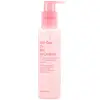What's inside
What's inside
 Key Ingredients
Key Ingredients

 Benefits
Benefits

 Concerns
Concerns

 Ingredients Side-by-side
Ingredients Side-by-side

Water
Skin ConditioningSodium Lauroyl Sarcosinate
CleansingCocamidopropyl Betaine
CleansingLauramide DEA
Diglycerin
HumectantPEG-120 Methyl Glucose Dioleate
EmulsifyingSodium Chloride
MaskingDisodium Cocoamphodiacetate
CleansingSodium Lauroyl Glutamate
Gluconolactone
Skin ConditioningCapryloyl Salicylic Acid
ExfoliatingButylene Glycol
HumectantHexylene Glycol
EmulsifyingPanthenol
Skin ConditioningMaltodextrin
AbsorbentCitric Acid
BufferingBeta-Glucan
Skin ConditioningSalix Alba Bark Extract
AstringentRosmarinus Officinalis Extract
AntimicrobialLavandula Angustifolia Extract
Skin ConditioningThymus Vulgaris Extract
PerfumingRosa Canina Fruit Extract
AstringentMentha Piperita Extract
CleansingJasminum Officinale Extract
MaskingHibiscus Sabdariffa Flower Extract
Skin ConditioningChamomilla Recutita Extract
Skin ConditioningCalendula Officinalis Extract
Skin ConditioningAspalathus Linearis Extract
Skin ConditioningCyanocobalamin
Skin ConditioningSodium Benzoate
MaskingChlorphenesin
Antimicrobial1,2-Hexanediol
Skin ConditioningWater, Sodium Lauroyl Sarcosinate, Cocamidopropyl Betaine, Lauramide DEA, Diglycerin, PEG-120 Methyl Glucose Dioleate, Sodium Chloride, Disodium Cocoamphodiacetate, Sodium Lauroyl Glutamate, Gluconolactone, Capryloyl Salicylic Acid, Butylene Glycol, Hexylene Glycol, Panthenol, Maltodextrin, Citric Acid, Beta-Glucan, Salix Alba Bark Extract, Rosmarinus Officinalis Extract, Lavandula Angustifolia Extract, Thymus Vulgaris Extract, Rosa Canina Fruit Extract, Mentha Piperita Extract, Jasminum Officinale Extract, Hibiscus Sabdariffa Flower Extract, Chamomilla Recutita Extract, Calendula Officinalis Extract, Aspalathus Linearis Extract, Cyanocobalamin, Sodium Benzoate, Chlorphenesin, 1,2-Hexanediol
Water
Skin ConditioningGlycerin
HumectantStearic Acid
CleansingMyristic Acid
CleansingPEG-32
HumectantPotassium Hydroxide
BufferingPalmitic Acid
EmollientLauric Acid
CleansingGlyceryl Stearate
EmollientPEG-100 Stearate
Lauramide DEA
Cocamidopropyl Betaine
CleansingPotassium Cocoate
EmulsifyingSalicylic Acid
MaskingSodium Chloride
MaskingArachidic Acid
CleansingLavandula Hybrida Oil
EmollientLinalool
PerfumingDisodium EDTA
Oleic Acid
EmollientLimonene
PerfumingAsiaticoside
AntioxidantAsiatic Acid
Skin ConditioningMadecassic Acid
Skin ConditioningWater, Glycerin, Stearic Acid, Myristic Acid, PEG-32, Potassium Hydroxide, Palmitic Acid, Lauric Acid, Glyceryl Stearate, PEG-100 Stearate, Lauramide DEA, Cocamidopropyl Betaine, Potassium Cocoate, Salicylic Acid, Sodium Chloride, Arachidic Acid, Lavandula Hybrida Oil, Linalool, Disodium EDTA, Oleic Acid, Limonene, Asiaticoside, Asiatic Acid, Madecassic Acid
 Reviews
Reviews

Ingredients Explained
These ingredients are found in both products.
Ingredients higher up in an ingredient list are typically present in a larger amount.
Cocamidopropyl Betaine is a fatty acid created by mixing similar compounds in coconut oil and dimethylaminopropylamine, a compound with two amino groups.
This ingredient is a surfactant and cleanser. It helps gather the dirt, pollutants, and other impurities in your skin to be washed away. It also helps thicken a product and make the texture more creamy.
Being created from coconut oil means Cocamidopropyl Betaine is hydrating for the skin.
While Cocamidopropyl Betaine was believed to be an allergen, a study from 2012 disproved this. It found two compounds in unpure Cocamidopropyl Betaine to be the irritants: aminoamide and 3-dimethylaminopropylamine. High-grade and pure Cocamidopropyl Betaine did not induce allergic reactions during this study.
Learn more about Cocamidopropyl BetaineWe don't have a description for Lauramide DEA yet.
Chances are, you eat sodium chloride every day. Sodium Chloride is also known as table salt.
This ingredient has many purposes in skincare: thickener, emulsifier, and exfoliator.
You'll most likely find this ingredient in cleansers where it is used to create a gel-like texture. As an emulsifier, it also prevents ingredients from separating.
There is much debate on whether this ingredient is comedogenic. The short answer - comedogenic ratings don't tell the whole story. Learn more about comegodenic ratings here.
The concensus about this ingredient causing acne seems to be divided. Research is needed to understand if this ingredient does cause acne.
Scrubs may use salt as the primary exfoliating ingredient.
Learn more about Sodium ChlorideWater. It's the most common cosmetic ingredient of all. You'll usually see it at the top of ingredient lists, meaning that it makes up the largest part of the product.
So why is it so popular? Water most often acts as a solvent - this means that it helps dissolve other ingredients into the formulation.
You'll also recognize water as that liquid we all need to stay alive. If you see this, drink a glass of water. Stay hydrated!
Learn more about Water